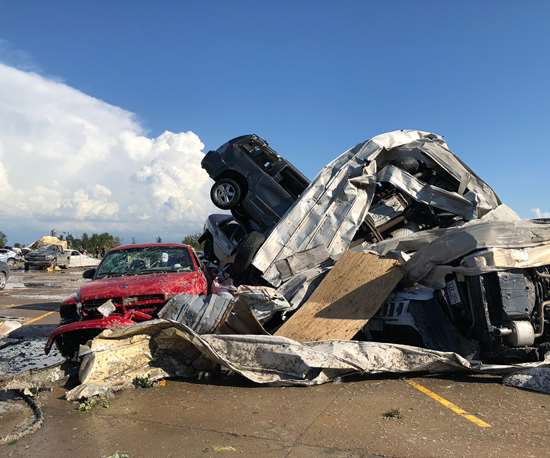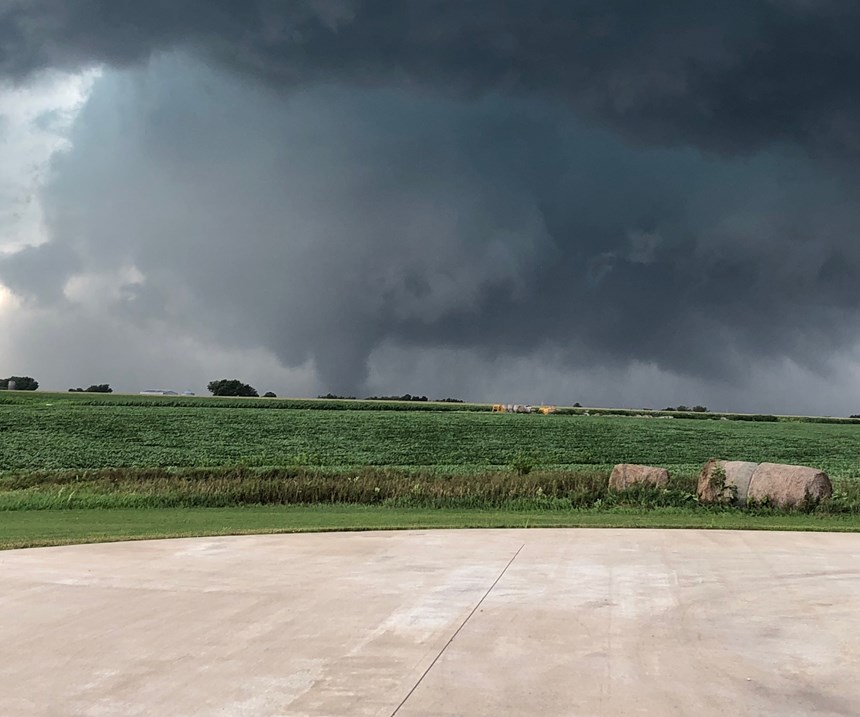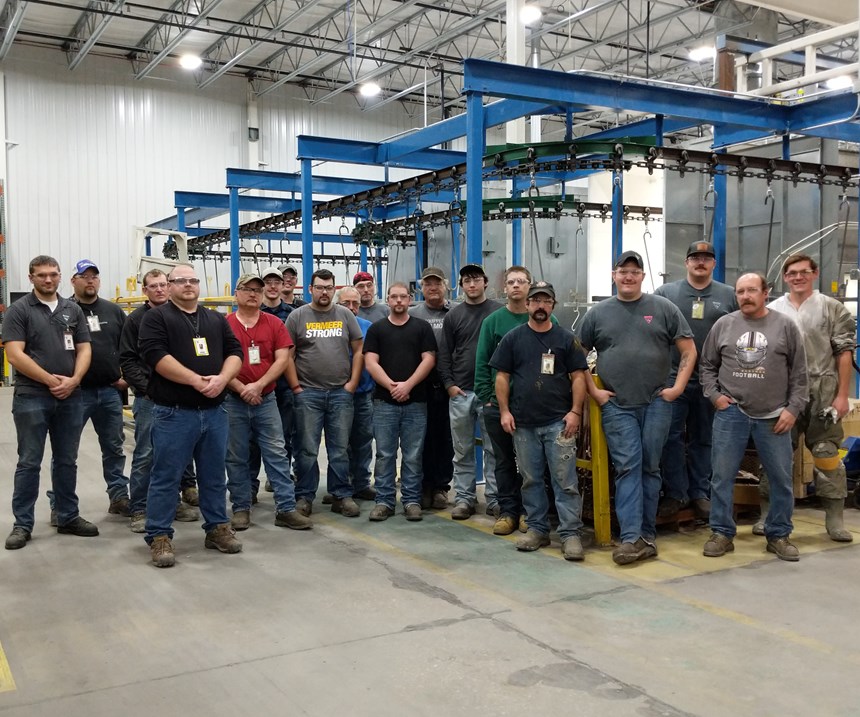Recessions, inflation and competition are things most manufacturers can handle with enough planning. An EF-3 tornado is something much different.
That was the case for Vermeer on the afternoon of July 19, 2018, when a storm ripped through its Pella, Iowa, facility and damaged several of its buildings where they manufacture and finish high-quality underground construction, surface mining, tree care, environmental and agricultural equipment.
Featured Content
Worse, the company and its 2,700 employees were hosting approximately 400 of its top customers during a 70th anniversary celebration, forcing everyone to scramble into tornado shelters to avoid impending disaster. Miraculously, only seven people were treated for minor injuries, but the damage to several of the buildings on the manufacturing campus were extensive, especially to the liquid-coating operations.
Tom Clawson, paint engineering manager at Vermeer, says that of the seven plants on the Pella campus, six had a liquid paint or powder coating system in them.
“We lost three lines,” he says. “It was significant. The next day we set up a command center with all the managers and started planning what we had to do to get operations back up and running.”
Recovering and Rebuilding
Like many original equipment manufacturers in the Midwest, Vermeer had emergency plans in place for facing a disaster such as a tornado or fire. But it was still a daunting task to walk through the debris to find out what worked, what didn’t and, more importantly, how they would keep the overall plant functioning and parts moving.
Vermeer management had assigned an Oct. 31 deadline for having a paint system fully operational in Plant 7, just over three months after the tornado.
Clawson and Andrew Turner, a Vermeer paint engineer, immediately began the arduous process of assessing which coating lines could be quickly repaired and which ones needed to be moved to another on-site facility and reconfigured to keep the coating lines moving.
“One of the main things we were trying to do was get the painting done elsewhere, if possible,” Turner says. “One plant that was damaged still had production capabilities, but did not have paint capabilities. That meant we had to get the other plants online and increase their throughput to handle the parts load for the other plant. That was the tricky part.”
Vermeer called in their coating equipment and suppliers to help them get things up and running again. Suppliers such as PEM, Axalta, Bulk Chemical and Spray Equipment quickly made it to Pella to help out their customer in need.
Seven Days a Week for Eight Weeks
Spray Equipment in Wichita, Kansas, was called upon first to disassemble some of the finishing lines and relocate them to other parts of the campus, a task that took about eight weeks working seven days a week, 12 hours a day.
“We’ve been involved in other major events for customers such as fires, but nothing of this magnitude,” says Tim Back, of Spray Equipment. “We were able to pull in manpower from some other projects, so that helped because we were trying to beat some deadlines.”
Turner jokes that Back and his team promised to be at Vermeer “rain or shine” to get the lines moved and the project completed. Indeed, they were often without a roof over their heads, and moving parts between buildings during inclement weather proved to be a challenge.
“Tim had more rain than he did shine, but his team did a great job in getting us set up again,” Turner says.
There was also a call to Kelly McCabe and John Kapsner at PEM to get a new SprayLean washer system built in record time. Not only did Vermeer want the 3-stage system in place by Oct. 31, but they needed one with a 48-inch window opening, and PEM’s largest size was only 36 inches.
“Our concept is a small footprint, and we’ve been asked many times to build wider units and have always avoided it,” McCabe says. “But Vermeer is one of our best customers and when they ask us to build a 48-inch unit, we knew we wanted to help them and, in the process, add another product to our lineup.”
Critical Supplier Support
PEM delivered the system and had it installed by Oct. 19, and Vermeer was able to start running production with it on Nov. 5, making for an incredible turnaround.
With the new equipment and different setup in its coating lines, they next needed Bulk Chemical to come in. Jeff Paschka from Bulk went to work running test panels to ensure the process would work as designed.
“We ran the panels in our lab and sent them to Vermeer for painting and salt-spray tests,” Paschka says. “We matched and went above Vermeer’s specifications, so we were pretty confident that these chemicals would work great in the new system.”
Vermeer also consulted with Joe Meiners from Axalta to make sure the liquid coating would work as expected in the reconfigured system.
“The product they had been using was pretty much dropped in and worked very well for them,” he says. “They designed a pretty small footprint, but the product was ready to work and meet their requirements.”
Clawson credits the quick turnaround to Vermeer employees and coating vendors who worked during very harsh conditions and many shifts to get the plant back up and running.
“The suppliers did a fantastic job for us, not only in the customer service they displayed but also in the quality of equipment and supplies,” he says. “We felt fortunate to have a team like that around us.”
Redundancies and Contingencies
By December, all of Vermeer’s paint operations were back up to the same production levels as before the tornado and, in some areas, levels were higher, Clawson says. The coating lines have kept pace, even as the company is still examining its operations and planning more permanent operations.
Vermeer learned several lessons in this crisis, the first which is to build in redundancies.
“When Gary Vermeer started this company, he was very clear that he wanted redundancy built into the operations,” Clawson says. “If we hadn’t followed that and had contingencies in place, we would not have been able to be in operation today.”
RELATED CONTENT
-
Drivers of Change
Is your metal finishing software ready for an upgrade?
-
Masking for Surface Finishing
Masking is employed in most any metal finishing operation where only a specifically defined area of the surface of a part must be exposed to a process. Conversely, masking may be employed on a surface where treatment is either not required or must be avoided. This article covers the many aspects of masking for metal finishing, including applications, methods and the various types of masking employed.
-
Paint Application Methods
An overview of spraying, dipping, flow coating, and everything in between.

























